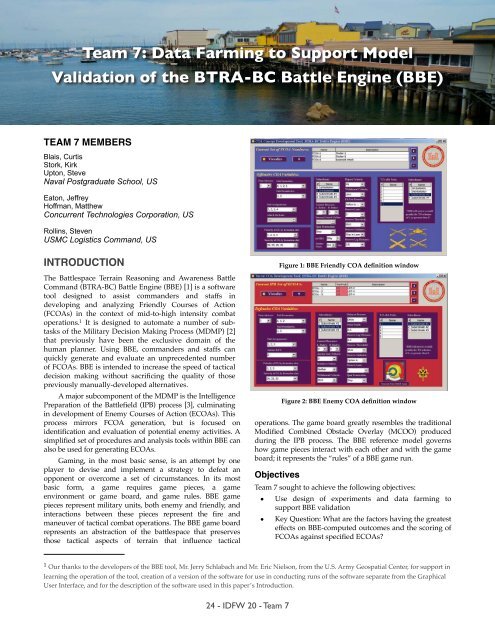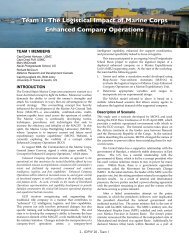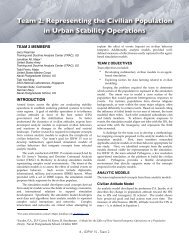pdf file - SEED Center for Data Farming - Naval Postgraduate School
pdf file - SEED Center for Data Farming - Naval Postgraduate School
pdf file - SEED Center for Data Farming - Naval Postgraduate School
You also want an ePaper? Increase the reach of your titles
YUMPU automatically turns print PDFs into web optimized ePapers that Google loves.
Team 7: <strong>Data</strong> <strong>Farming</strong> to Support Model<br />
Validation of the BTRA-BC Battle Engine (BBE)<br />
TEAM 7 MEMBERS<br />
Blais, Curtis<br />
Stork, Kirk<br />
Upton, Steve<br />
<strong>Naval</strong> <strong>Postgraduate</strong> <strong>School</strong>, US<br />
Eaton, Jeffrey<br />
Hoffman, Matthew<br />
Concurrent Technologies Corporation, US<br />
Rollins, Steven<br />
USMC Logistics Command, US<br />
INTRODUCTION<br />
The Battlespace Terrain Reasoning and Awareness Battle<br />
Command (BTRA-BC) Battle Engine (BBE) [1] is a software<br />
tool designed to assist commanders and staffs in<br />
developing and analyzing Friendly Courses of Action<br />
(FCOAs) in the context of mid-to-high intensity combat<br />
operations. 1 It is designed to automate a number of subtasks<br />
of the Military Decision Making Process (MDMP) [2]<br />
that previously have been the exclusive domain of the<br />
human planner. Using BBE, commanders and staffs can<br />
quickly generate and evaluate an unprecedented number<br />
of FCOAs. BBE is intended to increase the speed of tactical<br />
decision making without sacrificing the quality of those<br />
previously manually-developed alternatives.<br />
A major subcomponent of the MDMP is the Intelligence<br />
Preparation of the Battlefield (IPB) process [3], culminating<br />
in development of Enemy Courses of Action (ECOAs). This<br />
process mirrors FCOA generation, but is focused on<br />
identification and evaluation of potential enemy activities. A<br />
simplified set of procedures and analysis tools within BBE can<br />
also be used <strong>for</strong> generating ECOAs.<br />
Gaming, in the most basic sense, is an attempt by one<br />
player to devise and implement a strategy to defeat an<br />
opponent or overcome a set of circumstances. In its most<br />
basic <strong>for</strong>m, a game requires game pieces, a game<br />
environment or game board, and game rules. BBE game<br />
pieces represent military units, both enemy and friendly, and<br />
interactions between these pieces represent the fire and<br />
maneuver of tactical combat operations. The BBE game board<br />
represents an abstraction of the battlespace that preserves<br />
those tactical aspects of terrain that influence tactical<br />
Figure 1: BBE Friendly COA definition window<br />
Figure 2: BBE Enemy COA definition window<br />
operations. The game board greatly resembles the traditional<br />
Modified Combined Obstacle Overlay (MCOO) produced<br />
during the IPB process. The BBE reference model governs<br />
how game pieces interact with each other and with the game<br />
board; it represents the “rules” of a BBE game run.<br />
Objectives<br />
Team 7 sought to achieve the following objectives:<br />
• Use design of experiments and data farming to<br />
support BBE validation<br />
• Key Question: What are the factors having the greatest<br />
effects on BBE-computed outcomes and the scoring of<br />
FCOAs against specified ECOAs?<br />
1 Our thanks to the developers of the BBE tool, Mr. Jerry Schlabach and Mr. Eric Nielson, from the U.S. Army Geospatial <strong>Center</strong>, <strong>for</strong> support in<br />
learning the operation of the tool, creation of a version of the software <strong>for</strong> use in conducting runs of the software separate from the Graphical<br />
User Interface, and <strong>for</strong> the description of the software used in this paper’s Introduction.<br />
24 - IDFW 20 - Team 7




